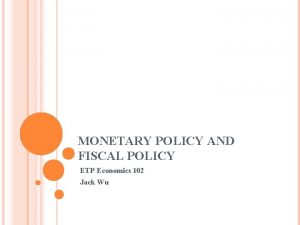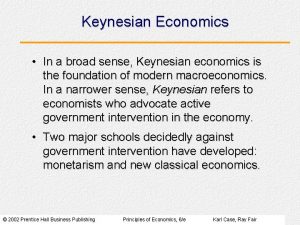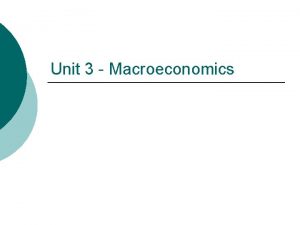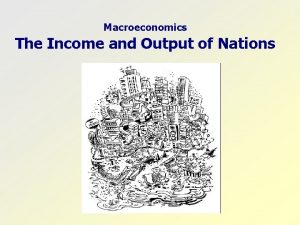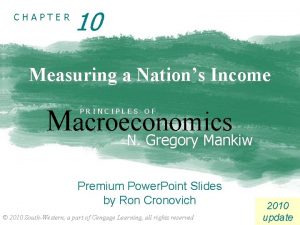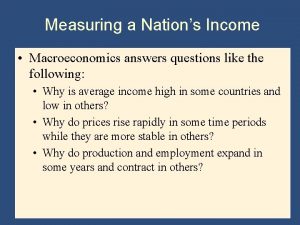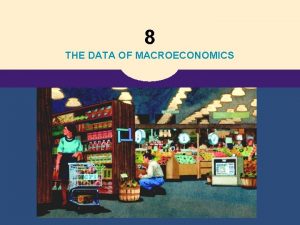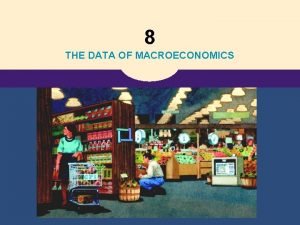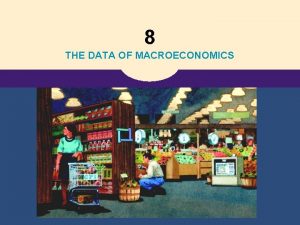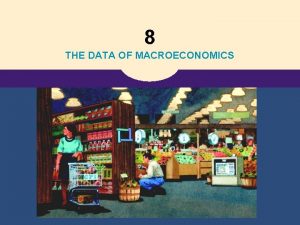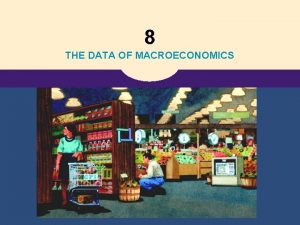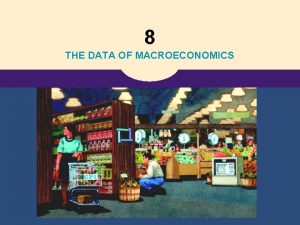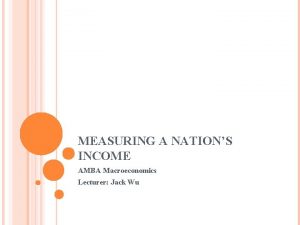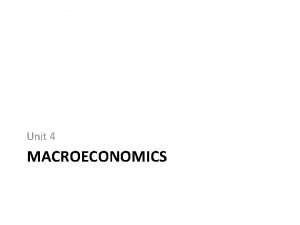Introduction to Macroeconomics Chapter 10 Measuring a Nations





























- Slides: 29

Introduction to Macroeconomics Chapter 10 Measuring a Nation’s Income GDP and other measures

Measuring a Country’s Income Gross Domestic Product: (GDP) measure of a country’s income and expenditure – Income is based on the amount of goods and services an economy produces – Expenditure is the amount of money needed to buy all the goods and services an economy produces In the economy as a whole: EXPENDITURE = INCOME Every dollar spent by buyers = Money received by firms

Gross Domestic Product The market value of all final goods and services produced within a country in a given period of time. • GDP measures how well an economy is doing over time • GDP measures how well an economy is doing compared to other economies • GDP measures fluctuations in the economy

Breakdown of GDP • Market Value: the amount of money needed to buy all goods and services produced in the economy at market prices • Final goods and services: Products that are for final sale – not intermediate goods used in the production of other goods • In a country: Counts only goods produced within the legal geographical boundaries of a country regardless of who makes them • In a given period: Counts only goods produced within that current year or quarter (not goods produced in the past)

Breakdown of GDP • Market Value: the amount of money needed to buy all goods and services produced in the economy at market prices • Final goods and services: Products that are for final sale – not intermediate goods used in the production of other goods • In a country: Counts only goods produced within the legal geographical boundaries of a country regardless of who makes them • In a given period: Counts only goods produced within that current year or quarter (not goods produced in the past)

Breakdown of GDP • Market Value: the amount of money needed to buy all goods and services produced in the economy at market prices • Final goods and services: Products that are for final sale – not intermediate goods used in the production of other goods • In a country: Counts only goods produced within the legal geographical boundaries of a country regardless of who makes them • In a given period: Counts only goods produced within that current year or quarter (not goods produced in the past)

Breakdown of GDP • Market Value: the amount of money needed to buy all goods and services produced in the economy at market prices • Final goods and services: Products that are for final sale – not intermediate goods used in the production of other goods • In a country: Counts only goods produced within the legal geographical boundaries of a country regardless of who makes them • In a given period: Counts only goods produced within that current year or quarter (not goods produced in the past)

Components of GDP Output Equation: Y = C + I + G + NX • Y = Output or GDP Amount of goods and services produced by an economy • C = Consumption Spending on goods and services by households • I = Investment Spending on capital goods by firms • G = Government Spending on goods and services by the government • NX = Net Exports - Imports

Finding GDP Data • Go to www. bea. gov • Click on Gross Domestic Product Interactive Tables • Begin using table Table 1. 1. 5 Gross Domestic Product (A) – – – Click on the Chart option Find each of the components of GDP “Modify” Change the years you are looking at How have each of the components changed? Can you identify periods of recession?

Application 1 Discuss how the following scenarios would impact GDP and which component of GDP is affected: • Panera Bread sees that its market share is growing in the US and decides to open 100 more locations. • Congress cuts the Pentagon’s budget by $20 billion. It can no longer invest in new robotic weapons. • Jane buys a new charger for her laptop that she purchases online. The charger is made in China. • The Smith family hires a nanny to watch their kids. They pay her cash. • The purchase on marijuana in Colorado vs. Nevada • Tom works for an NYC consulting firm that is based in Hong Kong.

Nominal GDP vs. Real GDP Nominal GDP: The value of output at current prices – takes into account price change and quantity change NGDP = P 1*Q 1 + P 2*Q 2 + P 3*Q 3 +…. + Pn*Qn Real GDP: The value of output at constant prices – takes into account only quantity change RGDP = Pb*Q 1 + Pb*Q 2 + Pb*Q 3 +…. + Pb*Qn Pb = prices at base year

Application 2. a Consider the economy of Fairview, which produces calculators, pens, and paper. Using the following table, determine the nominal GDP each year and real GDP if the base year is 2011. Calculators Pens Paper Price Quantity 2011 $20 100 $5 300 $10 600 2012 $20. 50 105 $5. 25 350 $11 640 2013 $21. 75 107 $5. 80 425 $12 645 What is the percentage change in each type of GDP?

Application 2. a Nominal GDP = P x Q Calculators Pens Paper GDP P Q Px. Q 2011 $20 100 $2, 000 $5 300 $1, 500 $10 600 $6, 000 2012 $20. 50 105 $2, 153 $5. 25 350 $1, 838 $11 640 $7, 040 $11, 031 2013 $21. 75 107 $2, 327 $5. 80 425 $2, 465 $12 645 $7, 740 $12, 532 $9, 500

Application 2. a Real GDP = P(2011) x Q Calculators Pens Paper GDP P Q Px. Q 2011 $20 100 $2, 000 $5 300 $1, 500 $10 600 $6, 000 2012 $20. 50 105 $2, 100 $5. 25 350 $1, 750 $11 640 $6, 400 $10, 250 2013 $21. 75 107 $2, 140 $5. 80 425 $2, 125 $12 645 $6, 450 $10, 715 $9, 500

Application Reflection Why does this matter? • • • This application shows the difference between real GDP and nominal GDP calculations Real GDP reflects only the increase in production of goods in the economy, keeping prices (or values) of those good constant Nominal GDP reflects both increase in price and increase in production of goods in the economy. Most Important Takeaway • Real and Nominal GDP both give important insights into what is happening in an economy. • They track production changes as well as price changes Muddiest Point?

Change in GDP • Change in nominal GDP – reflects changes in both prices and quantities produced • Change in real GDP – reflects only changes in quantities produced Real GDP is “corrected” for inflation Growth in production – growth in real GDP! Income and economic well being is rising!

Growth in GDP Nominal GDP Percent Change Real GDP Percent Change 2011 $9, 500 2012 $11, 030 16. 1% $10, 250 7. 9 % 2013 $12, 532 13. 6% $10, 715 4. 5%

Using GDP to understand prices •

Application 2. b Based on your earlier calculations – what is the GDP deflator each year? Can you calculate inflation based on this measure?

Application 2. b NOMINAL GDP REAL GDP Deflator Inflation 2011 $9, 500 100 - 2012 $11, 030 $10, 250 107 7. 6% 2013 $12, 532 $10, 715 117 8. 2% Inflation: Percentage change in price levels from last year to this year.

Application Reflection Why does this matter? • • • Because we have two measures of GDP – one with constant prices, one with current prices – the ratio between them gives us an idea about what is happening with prices over time GDP deflator measure the changes in prices overall in the economy based on changes in the value of goods produced Another measure of prices overall in the economy is the Consumer Price Index, which reflects prices changes based on the value of goods consumed in the economy Most Important Takeaway • Changes in the GDP deflator give an indication of changes in prices in the economy – therefore we can calculate inflation Muddiest Point?

GDP and Economic Well-being • GDP per capita – measure of a nation’s wealth distributed evenly across its population • Indicates the average standard of living that is possible in a country • Higher GDP per capita -- people are better able to satisfy their needs and wants

Finding GDP Data • Go to http: //databank. worldbank. org/data/home. aspx • Click on “World Development Indicators” – Choose 4 -5 countries from the list – In series – Choose GDP per capita (Constant 2010 US$) – In Time – Choose 2000 – 2015 (or recent 15 years) • Download the data – Download option Excel • Open Excel File – Copy data paste in new sheet (Transpose) – Add Year column in Column A – Create a line graph

Economic Well-being across the World 18 000 60 000 16 000 50 000 Nominal GDP per capita USD 14 000 12 000 40 000 10 000 30 000 8 000 20 000 6 000 4 000 10 000 2001 2002 2003 2004 2005 2006 2007 2008 2009 2010 2011 2012 2013 2014 China US Japan Germany 20012002200320042005200620072008200920102011201220132014 Sierra Leone Zambia Ukraine Uruguay Pakistan

Writing to Learn Exercise Consider all the components that make up GDP and how it defines “well-being” of the people in a country. • What is missing from this definition of well-being? • Is it all encompassing? • Can people in the US be better off that people in Germany just based on GDP per capita? Why or why not?

Despite the shortcomings… • Having a large GDP enables a country to afford better schools, a cleaner environment, health care, etc. • Many indicators of the quality of life are positively correlated with GDP. For example…

GDP and Life Expectancy in 12 countries Life expectancy (years) 90 Bangladesh China 80 Japan U. S. Mexico Brazil 70 Germany Russia Indonesia India 60 Pakistan 50 Nigeria 40 $0 $10 000 $20 000 $30 000 $40 000 Real GDP person $50 000 27

GDP and Average Schooling in 12 countries 14 Average years of school Germany Japan 12 10 China U. S. Russia Mexico 8 Brazil Indonesia 6 4 India 2 $0 $10 000 $20 000 $30 000 $40 000 Real GDP person $50 000 28

GDP and Water Quality in 12 countries Satisfaction with water quality (% of population) 100% Germany Indonesia Bangladesh 90% Japan Brazil 80% U. S. China 70% Mexico India 60% Pakistan 50% Russia Nigeria 40% $0 $10 000 $20 000 $30 000 $40 000 Real GDP person $50 000 29
 Chapter 31 open economy macroeconomics
Chapter 31 open economy macroeconomics Macroeconomics chapter 7
Macroeconomics chapter 7 Macroeconomics chapter 8
Macroeconomics chapter 8 Vertical supply curve
Vertical supply curve Introduction to model united nations
Introduction to model united nations Introduction of united nations
Introduction of united nations The colonies become new nations
The colonies become new nations Chapter 20 section 2 european nations settle north america
Chapter 20 section 2 european nations settle north america Chapter 18 the colonies become new nations
Chapter 18 the colonies become new nations Chapter 15 section 4 aggressors on the march
Chapter 15 section 4 aggressors on the march Chapter 31 section 4 aggressors invade nations
Chapter 31 section 4 aggressors invade nations Aggressors invade nations
Aggressors invade nations Chapter 22 section 1 the nations sick economy
Chapter 22 section 1 the nations sick economy Chapter 4 section 2 european nations settle north america
Chapter 4 section 2 european nations settle north america Chapter 20 section 2 european nations settle north america
Chapter 20 section 2 european nations settle north america Europeans claim muslim lands
Europeans claim muslim lands Chapter 20 section 2 european nations settle north america
Chapter 20 section 2 european nations settle north america System of national accounting
System of national accounting Components of macroeconomics
Components of macroeconomics Crowding out effect macroeconomics
Crowding out effect macroeconomics Crowding out effect macroeconomics
Crowding out effect macroeconomics Graphing monetary and fiscal policy interactions
Graphing monetary and fiscal policy interactions Define managerial economics
Define managerial economics Recessionary gap
Recessionary gap Micro and macro economics venn diagram
Micro and macro economics venn diagram What is macroeconomics
What is macroeconomics New classical macroeconomics
New classical macroeconomics New classical macroeconomics
New classical macroeconomics Crowding out
Crowding out 2012 macroeconomics frq
2012 macroeconomics frq




















